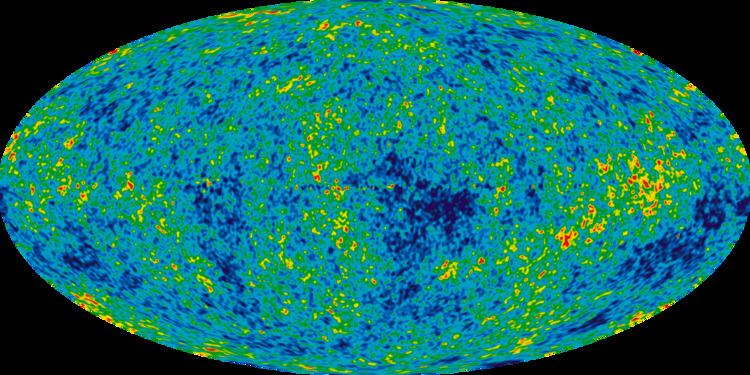 | ||
The Friedmann equations are a set of equations in physical cosmology that govern the expansion of space in homogeneous and isotropic models of the universe within the context of general relativity. They were first derived by Alexander Friedmann in 1922 from Einstein's field equations of gravitation for the Friedmann–Lemaître–Robertson–Walker metric and a perfect fluid with a given mass density
Contents
Assumptions
The Friedmann equations start with the simplifying assumption that the universe is spatially homogeneous and isotropic, i.e. the cosmological principle; empirically, this is justified on scales larger than ~100 Mpc. The cosmological principle implies that the metric of the universe must be of the form
where
Einstein's equations now relate the evolution of this scale factor to the pressure and energy of the matter in the universe. From FLRW metric we compute Christoffel symbols, then the Ricci tensor. With the stress–energy tensor for a perfect fluid, we substitute them into Einstein's field equations and the resulting equations are described below.
Equations
There are two independent Friedmann equations for modeling a homogeneous, isotropic universe. The first is:
which is derived from the 00 component of Einstein's field equations. The second is:
which is derived from the first together with the trace of Einstein's field equations.
Using the first equation, the second equation can be re-expressed as
which eliminates
These equations are sometimes simplified by replacing
to give:
The simplified form of the second equation is invariant under this transformation.
The Hubble parameter can change over time if other parts of the equation are time dependent (in particular the mass density, the vacuum energy, or the spatial curvature). Evaluating the Hubble parameter at the present time yields Hubble's constant which is the proportionality constant of Hubble's law. Applied to a fluid with a given equation of state, the Friedmann equations yield the time evolution and geometry of the universe as a function of the fluid density.
Some cosmologists call the second of these two equations the Friedmann acceleration equation and reserve the term Friedmann equation for only the first equation.
Density parameter
The density parameter,
To date, the critical density is estimated to be approximately five atoms (of monatomic hydrogen) per cubic metre, whereas the average density of ordinary matter in the Universe is believed to be 0.2 atoms per cubic metre, according to other sources one proton per 4 cubic metres.
A much greater density comes from the unidentified dark matter; both ordinary and dark matter contribute in favor of contraction of the universe. However, the largest part comes from so-called dark energy, which accounts for the cosmological constant term. Although the total density is equal to the critical density (exactly, up to measurement error), the dark energy does not lead to contraction of the universe but rather may accelerate its expansion. Therefore, the universe may expand forever.
An expression for the critical density is found by assuming Λ to be zero (as it is for all basic Friedmann universes) and setting the normalised spatial curvature, k, equal to zero. When the substitutions are applied to the first of the Friedmann equations we find:
The density parameter (useful for comparing different cosmological models) is then defined as:
This term originally was used as a means to determine the spatial geometry of the universe, where
The first Friedmann equation is often seen in terms of the present values of the density parameters, that is
Here
Useful solutions
The Friedmann equations can be solved exactly in presence of a perfect fluid with equation of state
where
In spatially flat case (k = 0), the solution for the scale factor is
where
Another important example is the case of a radiation-dominated universe, i.e., when
Note that this solution is not valid for domination of the cosmological constant, which corresponds to an
Solutions for other values of k can be found at Tersic, Balsa. "Lecture Notes on Astrophysics" (PDF). Retrieved 20 July 2011. .
Mixtures
If the matter is a mixture of two or more non-interacting fluids each with such an equation of state, then
holds separately for each such fluid f. In each case,
from which we get
For example, one can form a linear combination of such terms
where: A is the density of "dust" (ordinary matter, w = 0) when a = 1; B is the density of radiation (w = 1/3) when a = 1; and C is the density of "dark energy" (w=−1). One then substitutes this into
and solves for a as a function of time.
Rescaled Friedmann equation
Set
where
